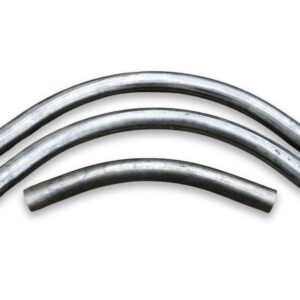Pneumatic conveying elbows change the flow direction of materials as they move through your dry bulk materials handling system. With such a simple task to perform, you might think that selecting the right size elbow is equally straightforward. But which components you install can make all the difference in flow efficiency, product quality, and ongoing maintenance costs.
To help you achieve optimal performance, let’s examine three key aspects of choosing the right size elbow: outer diameter (OD), radius of curvature, and specified degree.
Features of pneumatic conveying elbows
Outer diameter
The OD of your pneumatic conveying elbow must correspond with that of your existing pipework.
If your elbow is too narrow, it simply won’t fit. And if it’s too broad, it won’t be able to create an airtight seal. This could lead to pressure drops, leaks, and excessive power consumption, all of which seriously harm your productivity.
Before you order a replacement elbow, be sure to double-check the OD of the pipes you plan to connect them with. Otherwise, you’ll need to spend more money on a different-sized elbow and wait until it arrives to resume normal operations.
Radius of curvature
Most elbows fall into one of two categories: short-radius elbows and long-radius elbows. Which type you install has a significant impact on how your materials travel through your system. You should make your choice based on the characteristics of your materials, as well as your operational needs.
Since your system can include both types of bends, you need to decide in each case which radius of curvature would be best. You should also consider operational factors such as available floor space and increased speed at the end of a long stretch of pipe.
Short-radius elbows
An elbow that has a radius of curvature of 3-7x its OD is considered a short-radius elbow. Since they’re smaller, they take less material to make and are less expensive. Short-radius elbows are also much easier to install, meaning less system downtime when you need to replace one.
Due to their sharp angle, short-radius elbows tend to receive the force of materials in a single spot. For soft materials like grain or plastic pellets, this isn’t a problem. But if you’re conveying heavy or abrasive materials, this can increase the risk of elbow blowout. So you might find yourself replacing your elbows more frequently.
The greater force of impact can also increase product degradation. This might result in less salable product making it through your system and lower the quality your customers receive.
Long-radius elbows
An elbow is categorized as long radius when its radius of curvature is 8-14x its OD. Since these elbows offer a shallower angle of impact, the change of flow direction is more gradual.
Rather than impacting a single point, materials in long-radius elbows drag along the back of the pipe. This reduces wear and degradation in both the materials and the elbow itself. While they’re more expensive due to their size, long-radius elbows tend to have a longer lifespan. That means you can spend less on replacement parts and reduce system downtime.
However, if you convey particles that bounce, they can create multiple points of wear in a long-radius elbow. Since the damage isn’t localized, it can be challenging to monitor. This makes it harder to anticipate when a blowout will occur, possibly leading to more unexpected downtime. Thankfully, this isn’t usually a problem when transporting lighter particles.
Keep Reading: Guide to Selecting Pneumatic Conveying Bends
What radius of curvature do I need?
In most cases, companies that use a pneumatic conveying system prefer long-radius elbows. Their greater wear resistance means they require less maintenance and stay in your system longer. This reduces system downtime and lowers the amount you spend on replacement parts.
But if you’re conveying materials that smear, create streamers, or have small particles, you might be better off with a short-radius elbow. That’s because the increased drag in long-radius elbows can seriously damage these products, reducing their quality and harming your profits. Since these materials tend not to cause notable impact damage, they’re unlikely to harm short-radius elbows.
Specified degree
The degree of a pneumatic conveying elbow determines the angle at which the flow direction of materials will rise or fall. Just as with radius of curvature, the specified degree you select should depend on your materials, floor space, and operational needs. To demonstrate the differences between shallow- and sharp-angle elbows, let’s compare those of 30 and 90 degrees.
30-degree elbows
The shallow angle of a 30-degree elbow reduces your material’s force of impact as it hits the pipe wall. This helps to protect your elbow from damage and to minimize product degradation. And since a softer impact also reduces the energy and speed loss of the material, your system is likely to have lower energy requirements.
But depending on where your material inlets and outlets are positioned, installing shallow-angle elbows could result in:
- A pneumatic conveying system that takes up more space
- A greater distance for your materials to travel
Both of these can increase the cost of installing, maintaining, and running your system. So it’s important to consider these potential drawbacks against the benefits of reduced product and component damage to properly optimize your system.
90-degree elbows
In contrast to 30-degree elbows, the sharper angle of 90-degree elbows puts them at greater risk of impact damage, particularly when you convey heavy or dense materials. And even if you install a specialty 90-degree elbow designed for impact resistance, heavier materials will lose more speed and energy as they collide with it. That means your system will need more energy to convey materials effectively, which can eat into your profits.
On the other hand, the ability to quickly change the flow direction of your materials makes it possible to design a shorter, more compact pneumatic conveying system. That means your initial setup costs and space requirements could be lower, and the need to propel your materials across a shorter distance could reduce energy costs.
What specified degree do I need?
Whether you install a shallow- or sharp-angled elbow will depend on the material you convey. Shallow elbows offer greater impact resistance, making them suitable for heavy industry applications. But if you convey low-impact materials like plastics, food products, and powders, the faster direction change of sharp elbows might benefit you more.
As with elbow radius of curvature, your available floor space will also affect your pneumatic conveying system design decisions. If you’re short on space, 90-degree elbows might be necessary to build a functioning system regardless of your materials. But if you have room to spare, you could add plenty of 30-degree – or even 15-degree – elbows without concern.
Protect your system and materials with industry-leading custom elbows
As a general rule of thumb, shallow-angle long-radius elbows are the best choice for conveying heavy materials, whereas sharp-angle short-radius elbows are great for lighter particles. But even more important than getting the dimensions of your pneumatic conveying elbows correct is buying replacement components from a reliable expert source.
Visit our online store now to optimize your system with high-quality pneumatic conveying elbows that you can trust.
As part of Progressive Products Inc., PneuComponents has more than 40 years of experience in supplying durable industry-leading pneumatic conveying elbows. And as the industry’s first online pneumatic conveying retailer, you can instantly order quality parts through our online store without going through a lengthy sales process. We provide elbows of 30, 45, 60, and 90 degrees in any centerline radius, and can even custom manufacture components to your specifications.
-
Stainless Steel Bends$54.42 – $376.47
-
Carbon Steel Bends$22.83 – $198.45
-
Aluminum Bends$16.57 – $124.62



